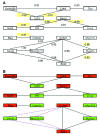Array analysis of gene expression in connexin-43 null astrocytes
- PMID: 12928503
- PMCID: PMC2651830
- DOI: 10.1152/physiolgenomics.00062.2003
Array analysis of gene expression in connexin-43 null astrocytes
Abstract
Connexin-43 (Cx43) is the most abundant gap junction protein in brain, where it is found primarily between astrocytes. Although the morphology of astrocytes from Cx43-null (knockout, KO) mice is similar to that of wild-type (WT) astrocytes, KO astrocytes exhibit reduced growth rate in culture. To evaluate the impact of deletion of Cx43 on other genes, including those encoding cell cycle proteins, we used DNA arrays to determine expression patterns in cultured astrocytes from sibling Cx43-null and WT mice. RNA samples extracted from astrocytes cultured from WT and Cx43-null neonatal mice were dye labeled and individually cohybridized with a reference of labeled cDNAs pooled from a variety of tissues on 8 gene arrays containing 8,975 mouse DNA sequences. Normal variability in expression of each gene was evaluated and incorporated into "expression scores" to statistically compare expression levels between WT and KO samples. In Cx43-null astrocytes, 4.1% of the 4,998 adequately quantifiable spots were found to have significantly (P < 0.05) decreased hybridization compared with controls, and 9.4% of the spots showed significantly higher hybridization. The significantly different spots corresponded to RNAs encoding 252 known proteins, many not previously linked to gap junctions, including transcription factors, channels and transporters, cell growth and death signals, enzymes and cell adhesion molecules. These data indicate a surprisingly high degree of impact of deletion of Cx43 on other astrocyte genes, implying that gap junction gene expression alters numerous processes in addition to intercellular communication.
Figures




Similar articles
-
Intercellular communication in spinal cord astrocytes: fine tuning between gap junctions and P2 nucleotide receptors in calcium wave propagation.J Neurosci. 2000 Feb 15;20(4):1435-45. doi: 10.1523/JNEUROSCI.20-04-01435.2000. J Neurosci. 2000. PMID: 10662834 Free PMC article.
-
Acute downregulation of Cx43 alters P2Y receptor expression levels in mouse spinal cord astrocytes.Glia. 2003 Apr 15;42(2):160-71. doi: 10.1002/glia.10197. Glia. 2003. PMID: 12655600 Free PMC article.
-
Genes controlling multiple functional pathways are transcriptionally regulated in connexin43 null mouse heart.Physiol Genomics. 2005 Feb 10;20(3):211-23. doi: 10.1152/physiolgenomics.00229.2003. Epub 2004 Dec 7. Physiol Genomics. 2005. PMID: 15585606
-
Consequences of impaired gap junctional communication in glial cells.Adv Exp Med Biol. 1999;468:373-81. doi: 10.1007/978-1-4615-4685-6_29. Adv Exp Med Biol. 1999. PMID: 10635043 Review.
-
Sensitivity of the brain transcriptome to connexin ablation.Biochim Biophys Acta. 2005 Jun 10;1711(2):183-96. doi: 10.1016/j.bbamem.2004.12.002. Epub 2004 Dec 22. Biochim Biophys Acta. 2005. PMID: 15955303 Review.
Cited by
-
Mouse Hepatitis Virus Infection Remodels Connexin43-Mediated Gap Junction Intercellular Communication In Vitro and In Vivo.J Virol. 2015 Dec 16;90(5):2586-99. doi: 10.1128/JVI.02420-15. J Virol. 2015. PMID: 26676788 Free PMC article.
-
Connexin subtype expression during oral carcinogenesis: A pilot study in patients with oral squamous cell carcinoma.Mol Clin Oncol. 2016 Feb;4(2):298-302. doi: 10.3892/mco.2015.685. Epub 2015 Nov 25. Mol Clin Oncol. 2016. PMID: 26893879 Free PMC article.
-
The role of neuronal connexins 36 and 45 in shaping spontaneous firing patterns in the developing retina.J Neurosci. 2011 Jul 6;31(27):9998-10008. doi: 10.1523/JNEUROSCI.5640-10.2011. J Neurosci. 2011. PMID: 21734291 Free PMC article.
-
Connexin Expression in Pituitary Adenomas and the Effects of Overexpression of Connexin 43 in Pituitary Tumor Cell Lines.Genes (Basel). 2022 Apr 12;13(4):674. doi: 10.3390/genes13040674. Genes (Basel). 2022. PMID: 35456480 Free PMC article.
-
Connexin 40 and ATP-dependent intercellular calcium wave in renal glomerular endothelial cells.Am J Physiol Regul Integr Comp Physiol. 2008 Jun;294(6):R1769-76. doi: 10.1152/ajpregu.00489.2007. Epub 2008 Apr 9. Am J Physiol Regul Integr Comp Physiol. 2008. PMID: 18401004 Free PMC article.
References
-
- Alberts B, Bray D, Lewis J, Raff M, Roberts K, Watson JD. Molecular Biology of the Cell. 3. New York: Garland; 1994.
-
- Britz-Cunningham SH, Shah MM, Zuppan CW, Fletcher WH. Mutations of the connexin43 gap-junction gene in patients with heart malformations and defects of laterality. N Engl J Med. 1995;332:1323–1329. - PubMed
-
- Butte A. The use and analysis of microarray data. Nat Rev Drug Discov. 2002;1:951–960. - PubMed
Publication types
MeSH terms
Substances
Grants and funding
LinkOut - more resources
Full Text Sources
Molecular Biology Databases
Research Materials
Miscellaneous

